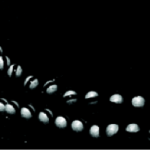- Derivation of new models of shear shallow flows on curved topography. Curved topographies for 2D flows will be assumed locally defined by a signed curvature and a unit normal to the bed. A cylindrical coordinates formulation will be used to obtain a unified model valid both for inclined edges and for arcs. Our hope is to use this formulation to achieve modeling for smooth topographies described by combinations of edges and arcs. Extensions to 3D flows will be achieved for some quadratic surfaces (Ellipsoid, parabolic cylinder, hyperbolic parabolic) as a first step of our investigations.Task1 : Shear shallow water flows on locally cylindrical topography (2D to 1D).Task 2 : Effects of density variation on depth-integrated models for granular flows
- Experiments and data collection for model improvement and validation. Calibration of bottom friction coefficient to be used in mathematical models. Experimental observations and measurements are crucial for models development. A series of laboratory experiments will be managed in Taiwan, in order to characterize the relevant parameters introduced in the mathematical models for the purpose of numerical investigation. As the modeling work is mainly based either on the experimental data or on the in-situ observation, the proposed experiments are not only for the purpose of model validation, but the data can provide with convincing evidence for the further improvement. The experiments will include channel experiments on hydraulic jumps and granular jumps, the velocity profiles and characters of the shear strength, etc.Task 3: Channel experiment on hydraulic jumps.Task 4: Jumps of granular flows, dada for calibrations.
- Numerical investigation, validations and software design. For arbitrary geometries we will now apply a “1D-meshing” process that defined smooth approximations using edges and arcs. More general description using B-splines (1D and 2D) will be investigated for long-term applications. Application to 3D sheared flows using curved approximations of the topography is the main challenge here. The first step is to propose tools for 1D profiles described by patches of cubic splines. Extensions to 2D surfaces will be achieved by tensor product for quadrangular meshes and for triangular meshes, based on our experience gained in the context of the plasma physics, we will investigate C1 finite element descriptions using Powell-Sabin(quadratic) and Bell(reduced-quintic). The numerical discretization will be performed by using both finite volume and finite element based approaches, allowing to perform comparisons in terms of accuracy and robustness.Task 5: 1-D local cylindrical code (Finite-Volume with Riemann Solver, stabilized finite element).Task 6: Code to code validation.Task 7: Comparison with experimental results and unreduced model on flat plane.
Privacy Overview
This website uses cookies so that we can provide you with the best user experience possible. Cookie information is stored in your browser and performs functions such as recognising you when you return to our website and helping our team to understand which sections of the website you find most interesting and useful.



